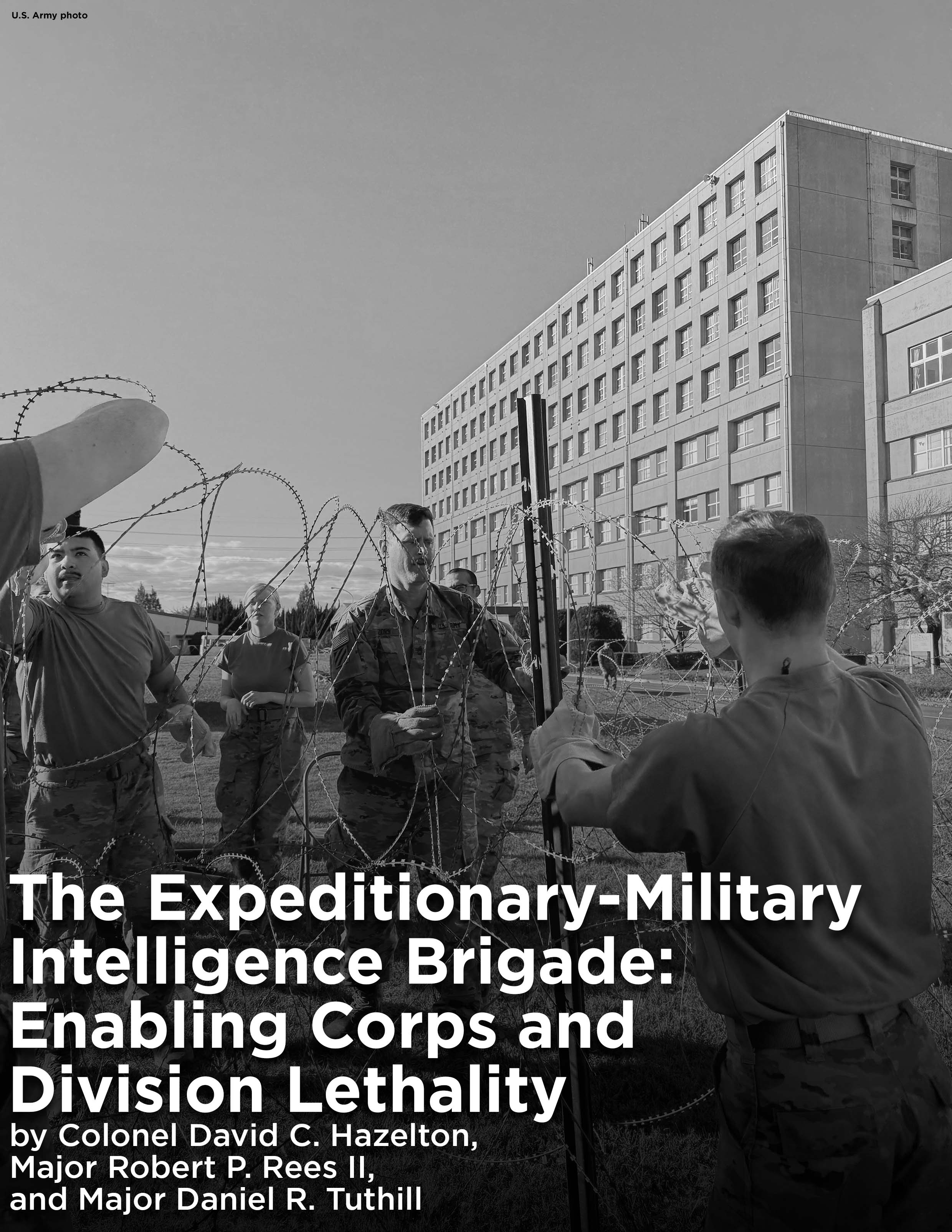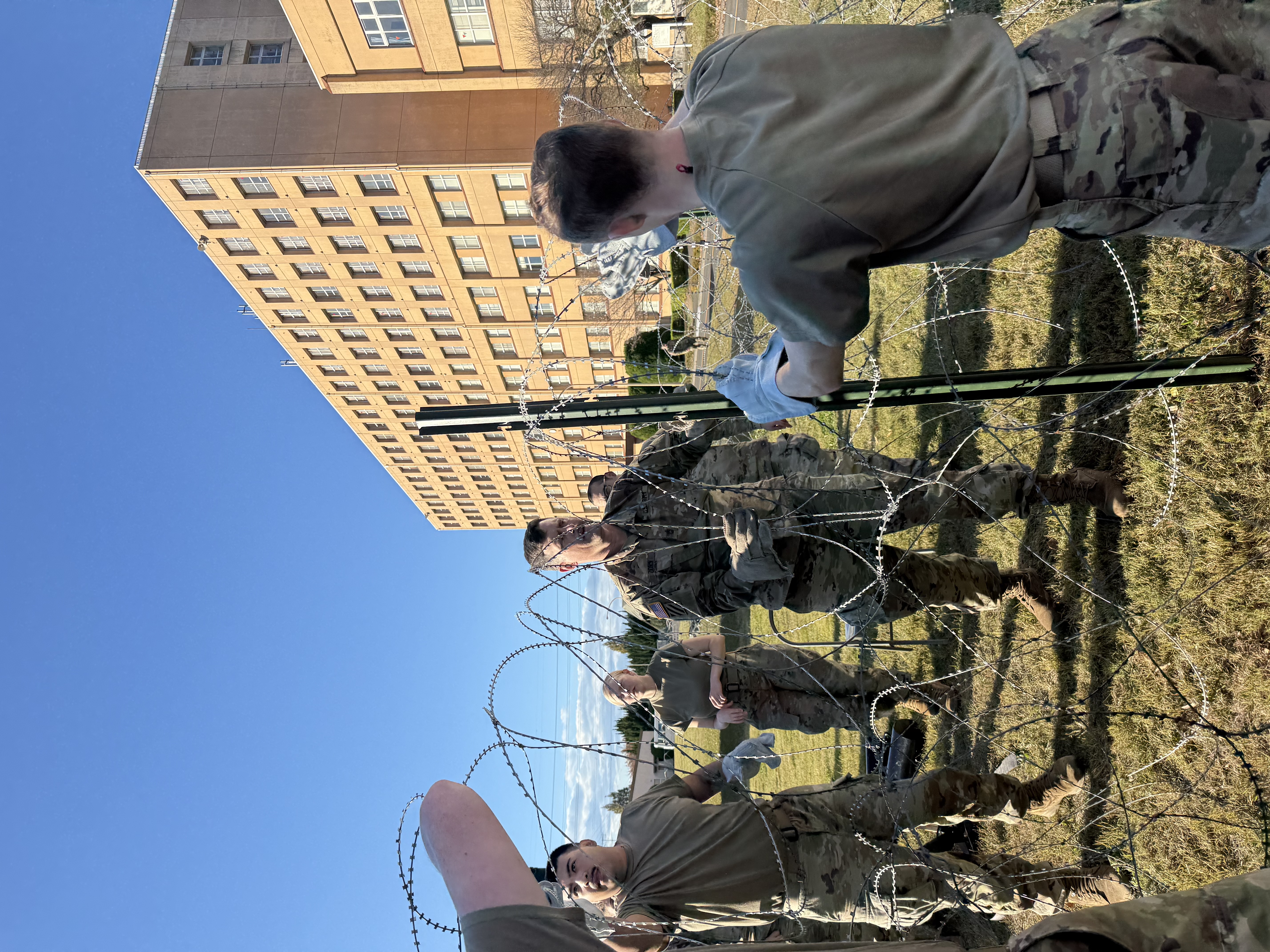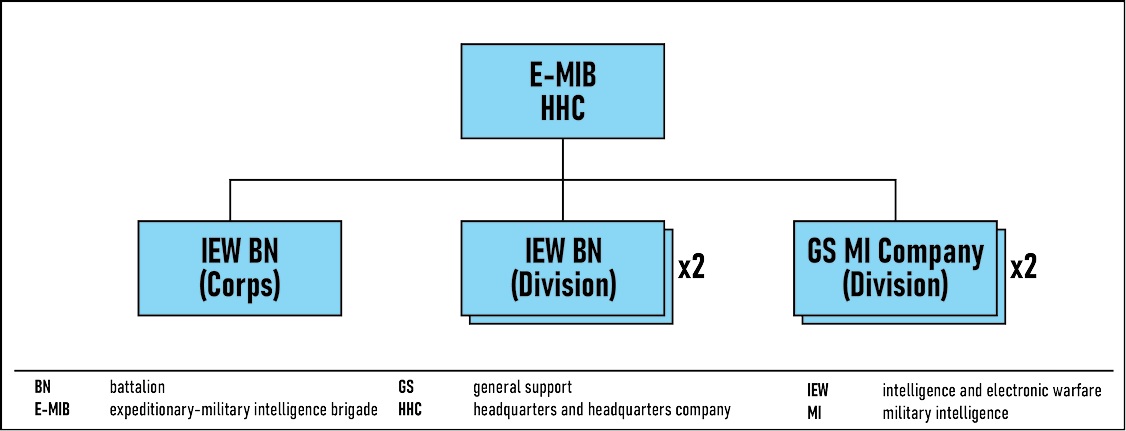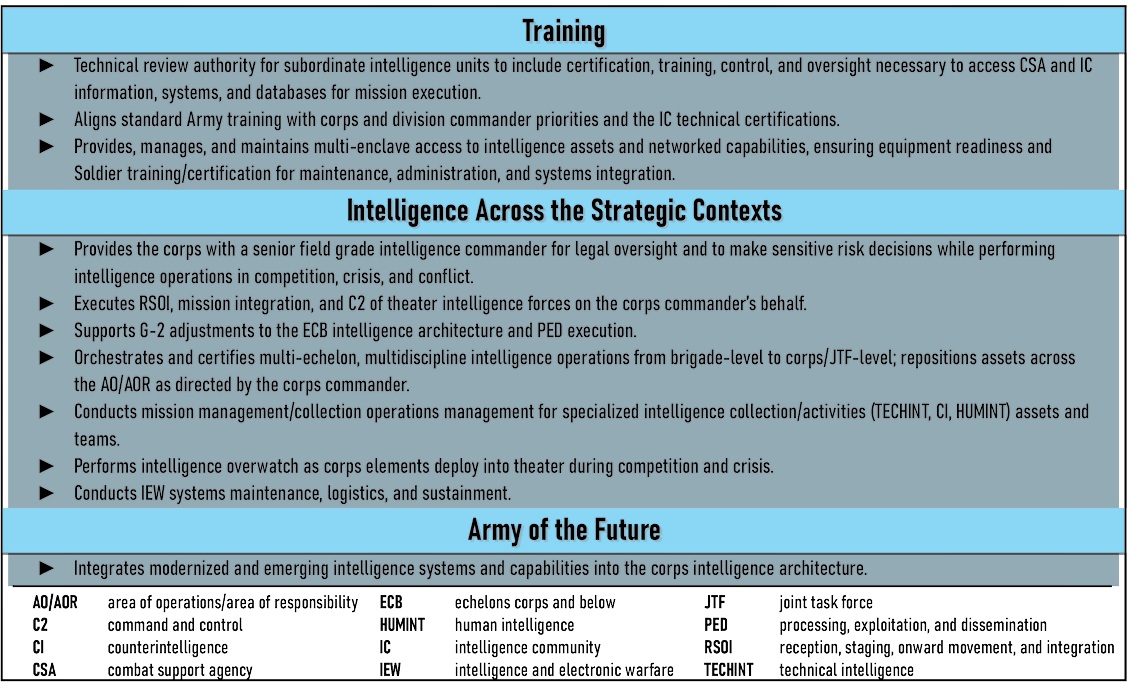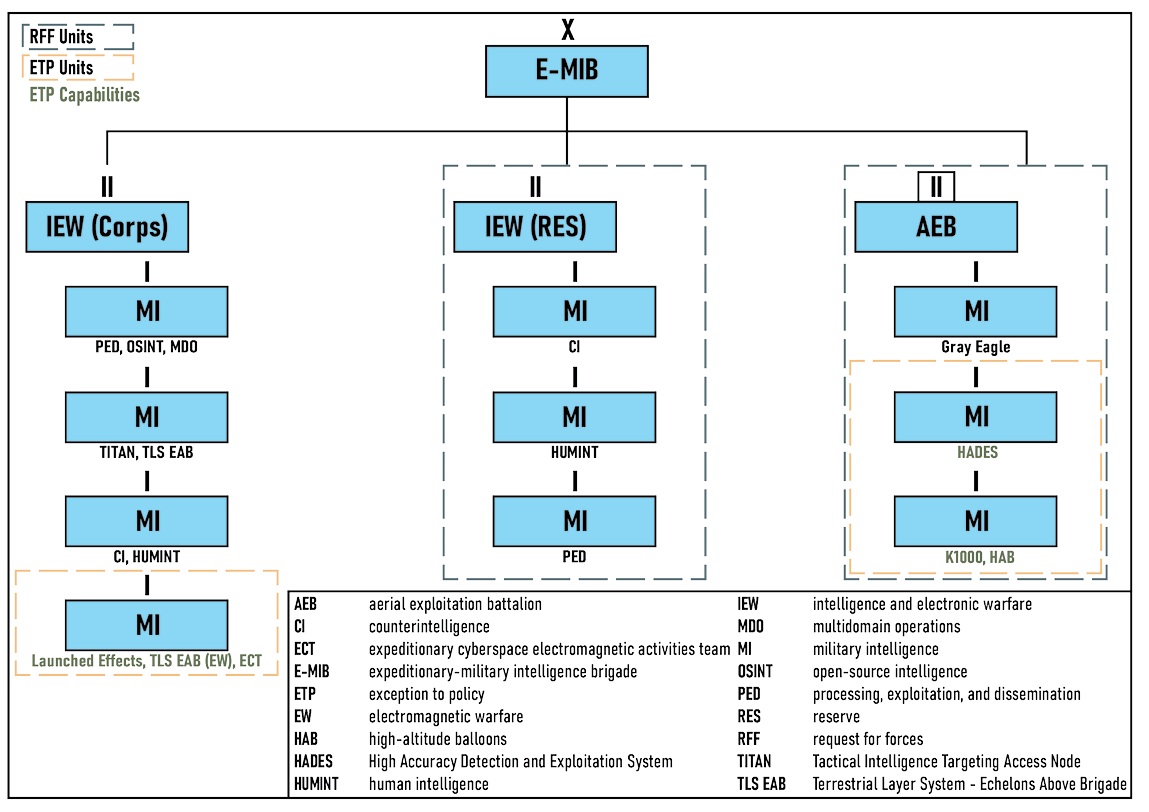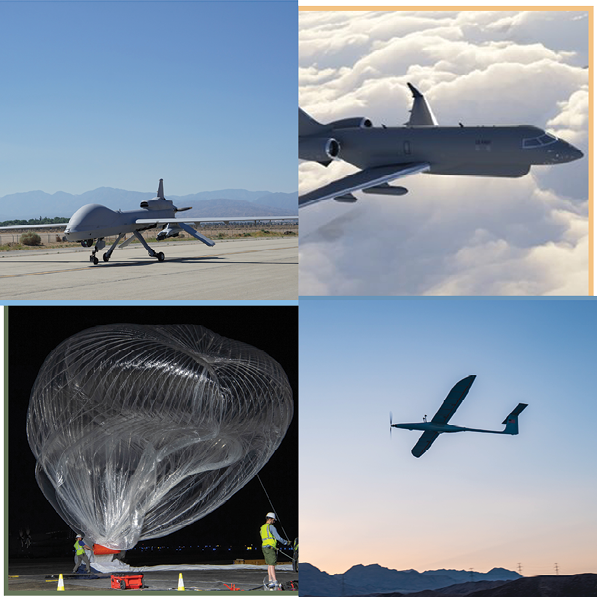The Expeditionary-Military Intelligence Brigade: Enabling Corps and Division Lethality
“Intelligence drives the conduct of operations and operations enable intelligence, making intelligence and operations inseparable. Additionally, intelligence supports Army leaders in creating complementary and reinforcing effects against enemy formations across all domains.”1 Operational aspects, from competition activities to deployment to lethality and protection during conflict, start with intelligence.
Army doctrine has long recognized several aspects of intelligence that each echelon must account for to provide effective intelligence at and across echelons. For example, in different locations, Field Manual (FM) 2-0, Intelligence, discusses the intelligence enterprise, intelligence architecture, intelligence operations, intelligence planning and coordination across echelons, collection management, deployment of intelligence capabilities, and intelligence training. It is easy to list these aspects of intelligence, but to apply them at echelon effectively is complex. Effectively employing these aspects is why the expeditionary-military intelligence brigade (E-MIB), including its headquarters and headquarters company (HHC), is essential to corps and division intelligence.
Corps Intelligence
The corps G-2, aided by the E-MIB, provides intelligence support to its corps headquarters during large-scale combat operations as part of a joint campaign. It must be prepared to support the subordinate two to five divisions of the corps. The corps G-2 manages the integration of joint and multinational intelligence capabilities into the ground operational and tactical fight and coordinates U.S. Intelligence and Security Command and U.S. intelligence community partnerships through the theater army G-2 and military intelligence (MI) brigade-theater.2
“To create unity of effort, the corps G-2 and E-MIB must collaborate to—
- Effectively execute intelligence activities.
- Continuously and mutually support intelligence training to create cohesion across the [echelons corps and below] ECB intelligence warfighting function.
- Routinely integrate higher-level augmentation, including joint and multinational intelligence elements.
- Task-organize intelligence capacity to subordinate divisions and units according to the corps commander’s intent.
- Sustain intelligence activities across multiple command nodes to support the corps commander’s decision making, targeting, and other staff processes.”3
The Expeditionary-Military Intelligence Brigade and Its Headquarters and Headquarters Company
The E-MIB is the primary MI unit assigned to the corps; the E-MIB commander is the principal advisor to the corps commander and works with the G-2 to execute intelligence operations. E-MIBs conduct multidiscipline intelligence operations to support the corps and subordinate divisions. Each E-MIB has collection capabilities that include open-source intelligence (OSINT) teams, signals intelligence (SIGINT) collection teams, counterintelligence (CI) teams, and human intelligence (HUMINT) collection teams. Additionally, the E-MIB assists the corps G-2 in planning and executing the intelligence task organization of assigned and attached intelligence elements, including support to divisions and select brigade combat teams. Figure 1 shows the basic structure of the E-MIB.
There is a unique relationship between each echelon’s G-2/S-2 and the MI unit. In general, the G-2/S-2 synchronizes and fights the intelligence warfighting function under the commander’s direction. At the same time, the MI unit conducts intelligence operations using the operations process, like any other unit, based on that unit’s mission.5 However, the role of the E-MIB and E-MIB HHC is different than the role of other MI units because the E-MIB is comprised of a mix of subordinate MI units: an intelligence and electronic warfare (IEW) battalion (corps) that also supports the corps, and an IEW battalion (division) or general support (GS) MI company that supports each division.
So, given that the E-MIB comprises an IEW battalion (corps) and IEW battalions (division) and/or GS MI companies, what is the role of the E-MIB HHC? The quick answer is that the E-MIB HHC is designed to receive, integrate, employ, and sustain organic and supporting intelligence enterprise elements and allocate capabilities across the corps according to the G-2’s concept of intelligence. However, the roles of the E-MIB commander and HHC are far more extensive, as illustrated in Figure 2. Figure 2 groups the roles into those conducted to support intelligence training, those performed during operations across the strategic contexts (competition, crisis, and conflict), and those designed to help transition corps intelligence to the Army of the future. It is important to understand that the corps G-2 staff is not resourced to perform these functions, and the corps and division warfighting function would be severely challenged to function effectively without the E-MIB HHC.
The 201st Expeditionary-Military Intelligence Brigade’s Experiences and Deep Sensing
Over the past several years, I Corps and the 201st E-MIB have grappled with the role of the E-MIB and E-MIB HHC. The results of past and ongoing planning, exercises, and operations are exciting. Some of the most exciting I Corps intelligence advancements center on what HHC, 201st E-MIB has learned about planning and executing the reception and integration of external units and capabilities.
A key capability of the E-MIB is to see and sense beyond the divisions to enable corps shaping and situational awareness. Apart from the corps combat aviation brigade, there are no organic intelligence, surveillance, and reconnaissance (ISR) platforms that a corps can task to conduct collection operations beyond its subordinate divisions. How then does the E-MIB conduct collection operations for the corps area of operations that extends beyond the reach of its organic collection capabilities? A corps must rely on requests for theater, joint, or national intelligence assets to answer its priority intelligence requirements, support targeting, conduct battle damage assessments, and provide situational understanding. E-MIB HHC requests for higher-level intelligence are clearly integral to operating as a joint force and conducting multidomain operations; however, wholesale reliance on external requests does not offer the same flexibility, reliability, or consistency that tasking organic capabilities provide. LTG Xavier Brunson, former I Corps Commander, alluded to this during a U.S. Senate Hearing on 17 September 2024:
According to FM 2-0, “a corps usually receives reinforcing capabilities and units from theater army, joint, or multinational echelons to conduct operations.”8 Because of their limited organic capabilities, corps require this external augmentation to close the deep sensing gap. A corps furnished with enablers to close the deep sensing gap must have the capability to plan, command and control, and integrate the operations of the reinforcing units. The corps G-2 generally does not have the operational or administrative capacity to provide the command and control necessary for newly aligned units; this is where the E-MIB HHC steps in.9
Request for Forces–A Solid Technique
Since 2022, I Corps has experimented with placing various external enablers and Reserve MI units under the 201st E-MIB during Operation Pathways’ campaigning operations through a request for forces (RFF). An RFF is a formal request made by a military command, and typically, it is submitted when the current units assigned cannot meet a requirement for additional forces or resources.10 In this case, the external resources temporarily provided necessary collection capabilities to conduct deep sensing across the I Corps area of operations. With these resources allocated, the 201st E-MIB trained on its mission of providing deep sensing to I Corps. This experiment created a symbiotic dependency between the 201st E-MIB HHC and the I Corps G-2 (and other I Corps staff) in which the G-2 focused on developing the collection requirements for the corps, freeing up the 201st E-MIB to plan and execute the collection operations. This actualized the corps G-2 and E-MIB responsibilities advocated by the U.S. Army Intelligence Center of Excellence (USAICoE) in its 2024 white paper How to Fight Army 2030 Echelons Corps and Below (ECB) Intelligence: “The corps G-2 is responsible for allocating intelligence forces across ECB [echelons corps and below] and delegating intelligence authorities.”11 and “The E-MIB is designed to receive, integrate, employ, and sustain external intelligence enterprise capabilities.”12
Before the RFF supplied more enablers, the 201st E-MIB primarily provided intelligence uplift to the G-2 by offering capabilities such as OSINT, SIGINT, and processing, exploitation, and dissemination (PED) teams. The collection resources assigned to the E-MIB provided minimal deep sensing for I Corps, consisting only of HUMINT teams, CI teams, and a limited number of Prophet-based SIGINT teams. Under this model, the primary value of the E-MIB to the corps lay in its capacity to contribute additional personnel as a force provider to the G-2 section.
Since 2022, the 201
The E-MIB must be ready to receive, optimally employ, and sustain each intelligence asset provided to the corps.13 The 201st E-MIB partners with multiple organizations to build the processes, expertise, and training that produce the capabilities to support the I Corps collection enterprise and properly execute the RFF for additional intelligence capability. To leverage the aligned resources of the I Corps intelligence warfighting function, the 201st E-MIB HHC organized an ISR Academy. This forum invites trainers from external units (such as the 116th MI Brigade [Aerial Intelligence], 5th Battlefield Coordination Detachment, 1st Air Support Operations Group [Air Force], and 1st Multi-Domain Task Force) to familiarize and educate 201st E-MIB personnel and other I Corps units’ S-2s and G-2s on the subjects of their collection capabilities, structure, and processes.
Additionally, the 201st E-MIB routinely trains in partnership with the 373rd Expeditionary MI Battalion (Army Reserve) to operate consistent with expectations for large-scale combat operations. Proliferating intelligence knowledge and expertise before any potential conflict is a vital function of the E-MIB that impacts units across the corps. Understanding how to fight for intelligence before the fight begins is essential to the adage “training as you fight”.
Theory Applied: Warfighter Exercise 25-02
During I Corps many iterations of Operation Pathways, the 201st E-MIB validated the key function of integrating external intelligence units. During its Warfighter Exercise 25-02 (WFX 25-02), I Corps took this training to the next level by integrating externally allocated units: the Army Reserve’s 373rd Expeditionary MI Battalion, an aerial exploitation battalion, and an electronic warfare company. (See Figure 3.)
By augmenting the organic collection capabilities of the E-MIB (i.e., OSINT, SIGINT, HUMINT, and CI), I Corps is rehearsing the concept of using the 201st E-MIB as the primary integrator of externally aligned intelligence assets as crises escalate into armed conflict. These external assets are more than a “warfighter dream sheet” of capabilities; they manifest the requirements of the corps to see and sense beyond divisions during large-scale combat operations. Focusing on the E-MIB’s responsibility to integrate external intelligence assets has enabled I Corps with a capability to find, fix, and finish its high-payoff targets, answer its priority intelligence requirements, and provide situational awareness. This deliberate approach to integrating external assets is how I Corps can operate as a tactical corps. It is charged not just with situational awareness but also with the capabilities to fulfill its purpose in decisively completing the kill chain.
In the lead-up to WFX 25-02, I Corps submitted exceptions to policy to outfit the requested aerial exploitation battalion with both existing and future exquisite capabilities. This strikes a deliberate balance between how the E-MIB conducts collection with existing Army inventory and how it conducts training with assets that are in development. These capabilities included:
- GE-ER (Gray Eagle Extended Range).15
- Kraus 1000 (K1000).16
- High Accuracy Detection and Exploitation System (HADES).17
- High-Altitude Balloon (HAB). 18
Using a mix of existing and future capabilities trains the E-MIB to employ the tools it has today as it prepares to integrate new sensors and platforms as they reach maturity. Operationally employing these future capabilities and educating the corps on their use is challenging for the E-MIB. By leveraging the 201st E-MIB as the primary integrator, the doctrinal and organizational aspects of the new equipment are advanced, and I Corps is better able to rehearse its wartime role of sensing and shaping.
Expeditionary-Military Intelligence Brigade Headquarters and Headquarters Company and Collection Management
The 201st E-MIB’s trained and ready capabilities work with the I Corps G-2 and take a central role in enabling the corps collection enterprise. The 201st S-2 is charged with collection operations management—turning the G-2’s collection requirements into an operational activity—and spearheads this critical integration with the I Corps G-2. USAICOE’s 2024 white paper makes note of this G-2/MI Commander balance: “The G-2/S-2 synchronizes and fights the intelligence warfighting function.”19 and “The MI unit commander is the chief of intelligence operations.”20 The E-MIB has the inherent responsibility to conduct intelligence collection operations that fulfill the requirements specified by the G-2 on behalf of the corps. The white paper hints at this tenuous balance: “The corps G-2 and E-MIB must collaborate to effectively execute intelligence activities . . . [and] task-organize intelligence capacity.”21 This dependency between the G-2 and MI command cannot be superficial: collection assets are limited, and bottom-up refinement is essential to best achieve the corps’ requirements for situational awareness, targeting, and battle damage assessment.
Conclusion
The E-MIB is not only the primary source of collection assets for a corps and division, but the E-MIB HHC also plays a pivotal role in enabling deep sensing. Without external augmentation, the E-MIB cannot fully achieve its purpose of deep sensing to find, fix, and finish the enemy. Any corps operationally employed with an assigned area of operations will require collection capability commensurate with that responsibility.22 External enablers will be critical to providing a corps with the ability to find, fix, and, most importantly, finish its targets.
The E-MIB HHC plays a critical role in the planning, reception, and integration of allocated external assets, enabling the corps to see beyond the divisions’ area of operations and achieve effects. These external enabler units and capabilities will vary based on the specific mission of a corps and the nature of the conflict. However, this ambiguity should spur the E-MIB to train more, not less, on the critical task of integration. Only then can the E-MIB fulfill its role of supporting a corps during large-scale combat operations. E-MIBs must prioritize continuous training and experimentation with various non-organic capabilities that will enable their corps to fight and win during large-scale combat operations. With this mentality, the E-MIB can “train as you fight” at the corps level of warfare.
Endnotes
1. Army Training and Doctrine Command, Army Intelligence Center of Excellence, White Paper: How to Fight Army 2030 Echelons Corps and Below (ECB) Intelligence (Fort Huachuca, AZ: U.S. Army Intelligence Center of Excellence, 10 August 2024), 2.
2. Ibid., 9.
3. Ibid.
4. Graphic adapted from Army Intelligence Center of Excellence, MI Pub 2-19.40 Transforming Division Intelligence (draft publication, 2025).
5. How to Fight Army 2030, 5.
6. Graphic derived from Colonel Rachel Sarles, Forces Command Deputy Chief of Staff G-2, email message to Ms. Beth Leeder, U.S. Army Intelligence Center of Excellence Director of Training and Doctrine, January 6, 2025. The email discusses LTG Anthony Hale’s talking points to describe the role and benefits of an expeditionary-military intelligence brigade headquarters.
7. Nomination Hearing of Lieutenant General Randall Reed, USAF, to Be General and Commander, United States Transportation Command and Lieutenant General Xavier T. Brunson, USA, to Be General and Commander, United Nations Command/Combined Forces Command/United States Forces Korea, Before the Senate Committee on Armed Services, 118th Cong. 53-54 (2024) (statement of Xavier T. Brunson, LTG, U.S. Army). https://www.armed-services.senate.gov/imo/media/doc/nomination_hearing.pdf.
8. Department of the Army, Field Manual (FM) 2-0, Intelligence (Washington, DC: Government Publishing Office [GPO], 01 October 2023), 7-16.
9. Department of the Army, Army Techniques Publication 2-19.3, Corps and Division Intelligence Techniques (Washington, DC: U.S. GPO, March 2023), 2-5; and How to Fight Army 2030, 9-10.
10. Office of the Chairman of the Joint Chiefs of Staff, Chairman of the Joint Chiefs of Staff Instruction 4310.01F, Logistics Planning Guidance for Pre-Positioned War Reserve Materiel (Washington, DC: The Joint Staff, 29 August 2022), B-8. https://www.jcs.mil/Portals/36/Documents/Library/Instructions/CJCSI%204310.01E.pdf.
11. How to Fight Army 2030, 11.
12. Ibid., 10.
13. Ibid.
14. Graphic adapted from author’s original.
15. “Gray Eagle Extended Range (GE-ER),” General Atomics Aeronautical, 2024, https://www.ga-asi.com/remotely-piloted-aircraft/gray-eagle-extended-range.
16. “Kraus Hamdani Aerospace Wins Contract to Provide the U.S. Navy with Its First Electric VTOL Unmanned Aerial System (UAS),” European Defence Review On-Line, April 04, 2024, https://www.edrmagazine.eu/kraus-hamdani-aerospace-wins-contract-to-provide-the-u-s-navy-with-its-first-electric-vtol-unmanned-aerial-system-uas.
17. Army Public Affairs, “Army Selects Sierra Nevada Corporation as Lead System Integrator for its High Accuracy Detection and Exploitation System,” U.S. Army Website, August 22, 2024, https://www.army.mil/article/279124/.
18. High Altitude (HA) Fact Sheet (Huntsville, AL: U.S. Army Space and Missile Defense Command, 2023), https://www.smdc.army.mil/Portals/38/Documents/Publications/Fact_Sheets/HA.pdf.
19. How to Fight Army 2030, 3.
20. Ibid.
21. Ibid., 9.
22. Department of the Army, FM 3-0, Operations (Washington, DC: U.S. GPO, 01 October 2022), 1-17, 2-2, 2-19, 4-19, 5-14, 6-38, 6-48.
COL David C. Hazelton is the 201st Expeditionary-Military Intelligence Brigade (E-MIB) Commander. His earlier assignments include 403rd Military Intelligence (MI) Detachment Commander, 532nd MI Battalion Commander, Special Operations Command-Korea executive officer, 501st MI Brigade S-3, 8th Army ACE Chief, 4th Stryker Brigade S-2, and two years with NATO/SHAPE in the J-2. COL Hazelton deployed to Afghanistan in support of Operation Enduring Freedom. He holds a bachelor of arts in political science from the U.S. Military Academy, master’s degrees from the University of Maryland, the National Intelligence University, the Command and General Staff College, and the Army War College, and a doctorate from North Central University.
MAJ Robert P. Rees II is the 201st E-MIB S-2 and collection operations manager. MAJ Rees’s previous assignments include 201st E-MIB deputy operations officer, S-2 for 2nd Battalion, 2nd Infantry Regiment, 3rd Infantry Brigade Combat Team, 1st Infantry Division, 513th MI Brigade-Theater’s Theater Ground Intelligence Center Company Commander, 311th MI Battalion assistant S-3, 2nd Battalion 35th Infantry Regiment, 3rd Infantry Brigade Combat Team, 25th Infantry Division battalion S-2, and 5th Battlefield Coordination Detachment Ground Liaison Officer. MAJ Rees holds a bachelor of arts in criminal justice from Eastern Kentucky University, a master of arts in intelligence studies from American Military University, and a master’s degree in operational studies from Command and General Staff College.
MAJ Daniel R. Tuthill is the 502nd Intelligence and Electronic Warfare Battalion (Corps) S-3. He previously served as the I Corps collection manager. MAJ Tuthill’s other assignments include Commander of the MI company at 1st Special Forces Group (A), 4th Battalion, 160th Special Operations Aviation Regiment (Airborne) S-2, and multiple jobs within 2nd Brigade Combat Team, 101st Airborne Division (Air Assault). He is an alum of the Junior Officer Cryptologic Career Program and has deployed numerous times in support of combat operations worldwide. MAJ Tuthill holds a bachelor of arts in supply chain management from Michigan State University, a master of professional studies in cybersecurity risk management from Georgetown University, and a master’s in operational studies from the Command and General Staff College.
